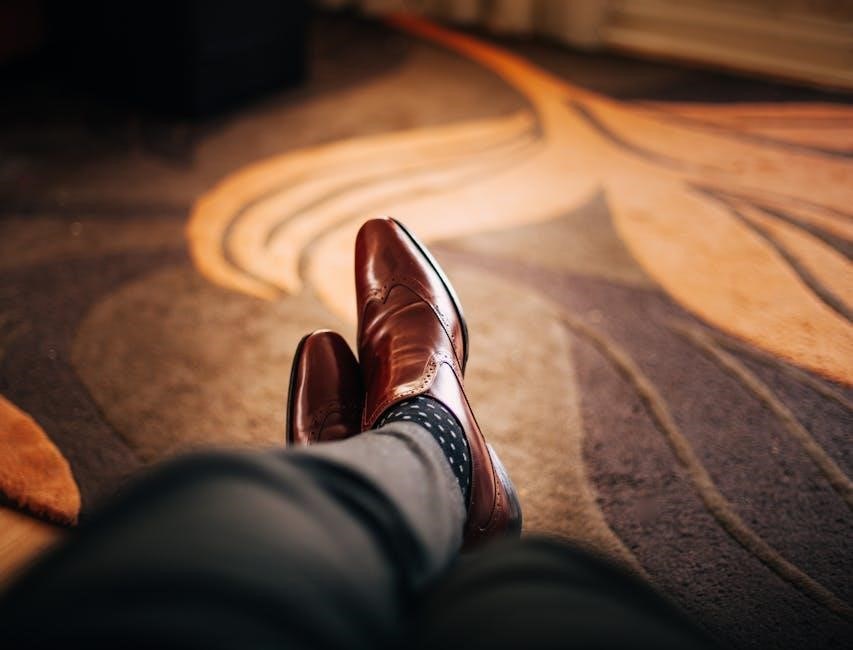Compression socks are specialized hosiery designed to provide graduated pressure‚ tightest at the ankle and decreasing upward‚ to improve blood flow and reduce swelling. Measured in millimeters of mercury (mmHg)‚ compression levels vary to suit different needs‚ from mild support for daily use to higher pressures for medical conditions. This guide explores the benefits‚ levels‚ and proper use of compression socks to help you make informed choices for your health and comfort.
1.1 Understanding mmHg in Compression Socks
Millimeters of mercury (mmHg) measures the pressure applied by compression socks. It indicates how tightly the socks squeeze the legs‚ with higher numbers meaning greater pressure. Compression levels range from mild (8-15 mmHg) to extra-firm (30-40 mmHg)‚ providing targeted support for blood flow and swelling reduction. Understanding mmHg helps choose the right compression for specific needs‚ ensuring comfort and effectiveness.
1.2 Importance of Graduated Compression
Graduated compression‚ where pressure decreases from the ankle upward‚ enhances blood flow and reduces swelling. This design ensures optimal circulation‚ preventing blood from pooling in the legs. It alleviates discomfort‚ fatigue‚ and promotes healthier leg function‚ making it essential for both medical and everyday use to support overall leg health effectively.
Benefits of Using Compression Socks
Compression socks reduce swelling‚ improve blood flow‚ and alleviate pain‚ enhancing overall leg health. They are ideal for athletes‚ travelers‚ and individuals with medical conditions‚ promoting comfort and recovery.
2.1 Improved Blood Circulation
Compression socks enhance blood circulation by applying graduated pressure‚ which helps push blood upward toward the heart. This reduces venous pressure and improves oxygen delivery to tissues‚ benefiting athletes and individuals with circulatory issues. Enhanced circulation can also prevent blood pooling‚ reducing the risk of swelling and promoting overall leg health and energy levels.
2.2 Swelling Reduction
Compression socks reduce swelling by applying graduated pressure‚ which prevents fluid from accumulating in the legs. This is particularly beneficial for individuals who spend long periods standing or sitting‚ as it improves comfort and reduces fatigue. By promoting better blood flow‚ compression socks are especially helpful for those with edema or varicose veins‚ enhancing overall leg health and well-being.
2.3 Pain Relief and Recovery
Compression socks provide significant pain relief and aid in recovery by improving blood flow and reducing muscle soreness. Graduated compression helps minimize inflammation and discomfort‚ making them ideal for athletes and individuals recovering from medical procedures. They are particularly effective for conditions like varicose veins‚ with higher levels (20-30 mmHg) offering enhanced support for pain management and swelling reduction.

Compression Levels Explained
Compression levels range from mild (8-15 mmHg) to extra-firm (30-40 mmHg)‚ providing varying degrees of support for improving circulation‚ reducing swelling‚ and managing pain effectively.
3.1 8-15 mmHg: Mild Compression
8-15 mmHg is the mildest compression level‚ offering light support for improving circulation and reducing minor swelling. Ideal for everyday wear‚ it’s perfect for active individuals‚ travelers‚ or those who sit for long periods‚ providing comfort while preventing fatigue and promoting healthy blood flow.
3.2 15-20 mmHg: Moderate Compression
15-20 mmHg compression provides moderate support‚ ideal for addressing mild to moderate conditions such as varicose veins and edema. Often recommended for those who stand or sit for long periods‚ it helps reduce swelling and discomfort‚ promoting better blood circulation and offering a balance of support and comfort for everyday use and travel.
3.3 20-30 mmHg: Firm Compression
20-30 mmHg offers firm compression‚ suitable for addressing moderate to severe conditions like varicose veins and edema. It is commonly prescribed for medical conditions‚ post-recovery‚ and athletic recovery‚ providing strong support to improve circulation and reduce swelling. This level is ideal for individuals needing higher pressure without extreme tightness‚ balancing effectiveness and comfort for specific medical or active lifestyles.
3.4 30-40 mmHg: Extra-Firm Compression
30-40 mmHg is the highest level of compression‚ designed for severe conditions like lymphedema‚ deep vein thrombosis (DVT)‚ or significant swelling. It provides maximum support and pressure‚ typically prescribed by doctors for medical conditions requiring intense therapy. Extra-firm compression is not suitable for everyone and should only be used under professional guidance to ensure safety and effectiveness.

Who Should Use Compression Socks?
Compression socks are ideal for athletes‚ individuals with varicose veins‚ edema‚ or circulatory issues‚ and those needing support during long periods of sitting or standing.
4.1 Athletes and Active Individuals
Athletes and active individuals benefit from compression socks as they enhance muscle recovery‚ improve blood circulation‚ and reduce fatigue. The graduated pressure helps prevent muscle soreness and supports performance during sports. Many opt for 15-20 mmHg or 20-30 mmHg levels to balance comfort and support‚ making them ideal for running‚ training‚ and post-workout recovery.
4.2 People with Varicose Veins or Edema
Compression socks are essential for individuals with varicose veins or edema‚ offering support and improving circulation.
Typically‚ 15-20 mmHg to 30-40 mmHg levels are recommended to reduce swelling and alleviate pain.
They provide graduated pressure‚ which helps manage symptoms effectively.
Consulting a healthcare professional ensures the right compression level is chosen for optimal benefit and comfort.
4.3 Individuals with Medical Conditions
Compression socks are highly beneficial for individuals with medical conditions like deep vein thrombosis (DVT)‚ post-surgery recovery‚ or lymphedema. Higher compression levels (20-30 mmHg or 30-40 mmHg) provide firm support to manage swelling and pain. They promote blood flow and prevent complications‚ making them a prescribed solution for various health issues. Always consult a healthcare provider for the appropriate level.
How to Choose the Right Compression Level
Assess your needs‚ activity level‚ and medical conditions to select the appropriate compression level. Consult a healthcare professional to ensure the correct mmHg for optimal benefits and safety.
5.1 Assessing Your Needs
Evaluate your lifestyle‚ medical conditions‚ and activity level to determine the right compression level. Consider whether you need support for daily activities‚ sports‚ or managing conditions like varicose veins or swelling. Your specific requirements will guide the selection of appropriate mmHg levels to ensure comfort and effectiveness for your unique situation.
5.2 Consulting a Healthcare Professional
Consulting a healthcare professional is crucial to determine the most suitable compression level for your needs. They will assess your medical history‚ symptoms‚ and lifestyle to recommend the appropriate mmHg level. This ensures safe and effective use of compression socks‚ especially for medical conditions requiring higher pressures‚ such as 30-40 mmHg for severe cases.

How to Measure for Compression Socks
Accurate measurements are essential for proper fit. Use sizing charts and measure calf and ankle circumference at the right time‚ typically in the morning‚ for best results.
6.1 Understanding Sizing Charts
Sizing charts for compression socks vary by brand but typically categorize sizes based on calf and ankle measurements. These charts help ensure a proper fit‚ which is crucial for effectiveness. Most charts provide circumference measurements corresponding to small‚ medium‚ large‚ and extra-large sizes. Always refer to the manufacturer’s specific guidelines for accurate sizing.
6.2 Measuring at the Right Time
Measure your legs in the morning when swelling is typically minimal for the most accurate fit. Consistency is key—always measure at the same time of day. This ensures the compression socks provide the correct pressure and comfort throughout the day. Proper timing helps avoid discrepancies and guarantees optimal effectiveness of the compression therapy.

When to Wear Compression Socks
Wear compression socks during physical activity‚ travel‚ or long periods of sitting to reduce swelling and enhance circulation. They are also beneficial post-recovery and for medical conditions.
7.1 During Physical Activity
Compression socks are ideal for athletes and active individuals during workouts or sports. They improve blood circulation‚ reduce muscle strain‚ and prevent swelling. Higher compression levels (15-20 mmHg or 20-30 mmHg) are often recommended for running‚ cycling‚ or high-intensity activities to enhance performance and aid recovery. They provide support and stability‚ making them a popular choice among fitness enthusiasts.
7.2 For Travel or Long Periods of Sitting
Compression socks are highly beneficial during travel or prolonged sitting‚ as they improve blood flow and reduce swelling. Sitting for extended periods can lead to fluid retention in the legs‚ but compression socks‚ typically in the 15-20 mmHg range‚ help prevent this. They are especially recommended for long flights or drives to minimize leg fatigue and discomfort.
7.4 Post-Recovery and Medical Procedures
Compression socks are often recommended after medical procedures or surgeries to reduce swelling and promote healing. Higher compression levels‚ such as 20-30 mmHg or 30-40 mmHg‚ are commonly prescribed to prevent complications like blood clots or edema. They provide consistent pressure to improve blood flow‚ aiding in faster recovery and reducing discomfort during the healing process.

Materials and Brands Overview
Compression socks are made from breathable materials like nylon and spandex for comfort and durability. Popular brands include SB SOX‚ Dr. Socko‚ and Physix Gear Sport‚ offering reliable compression levels and stylish designs to suit various needs and preferences.
8.1 Common Materials Used
Compression socks are typically made from breathable‚ elastic materials like nylon‚ spandex‚ and moisture-wicking fabrics. These materials ensure comfort‚ durability‚ and effective compression. Many brands‚ such as SB SOX and Dr. Socko‚ use high-quality blends to enhance flexibility and support. Some socks feature seamless construction or cushioned soles for added comfort during extended wear.
8.2 Recommended Brands
Compression socks are made from breathable‚ elastic materials like nylon‚ spandex‚ and moisture-wicking fabrics. These materials ensure comfort‚ durability‚ and effective compression. Many brands use high-quality blends for flexibility and support‚ with features like seamless construction or cushioned soles for added comfort during extended wear.

Tips for Wearing Compression Socks
Wear compression socks snugly without wrinkles‚ ensuring proper fit. Replace them every 3-6 months for optimal support. Wash in mild detergent to maintain elasticity and compression effectiveness.
9.1 Proper Technique
Put on compression socks first thing in the morning when legs are less swollen. Start at the toes‚ gently pulling up without bunching fabric. Avoid wrinkles or folds to ensure even pressure. Use donning gloves if needed for easier application. Proper fit ensures maximum benefits and prevents discomfort throughout the day.
9.2 Care and Maintenance
Hand wash compression socks with mild detergent‚ avoiding fabric softeners. Air dry away from direct sunlight to maintain elasticity. Store in a cool‚ dry place to prevent damage. Regular washing and proper storage extend lifespan. Rotate pairs to ensure even wear. Follow manufacturer guidelines for machine washing‚ using a mesh laundry bag if needed.
Effectiveness and Scientific Evidence
Studies confirm compression socks improve blood circulation‚ reduce swelling‚ and alleviate pain. Clinical trials support their use for medical conditions‚ with expert recommendations backing their effectiveness for varicose veins and edema.
10.1 Studies on Compression Therapy
Research demonstrates that compression therapy significantly improves blood flow and reduces swelling. Studies show that 15-20 mmHg and 20-30 mmHg levels effectively alleviate symptoms of varicose veins and edema. Clinical trials also highlight their benefits for post-surgery recovery and sports performance‚ with measurable improvements in circulation and pain reduction‚ supporting their medical and therapeutic use across various conditions.
10.2 User Testimonials and Reviews
Users praise compression socks for their comfort and effectiveness. Many report reduced swelling and improved circulation‚ especially during travel or physical activity. Athletes highlight enhanced recovery‚ while individuals with varicose veins note significant pain relief. Overall‚ testimonials consistently emphasize the positive impact of compression socks on daily comfort and medical conditions‚ making them a highly recommended choice.
